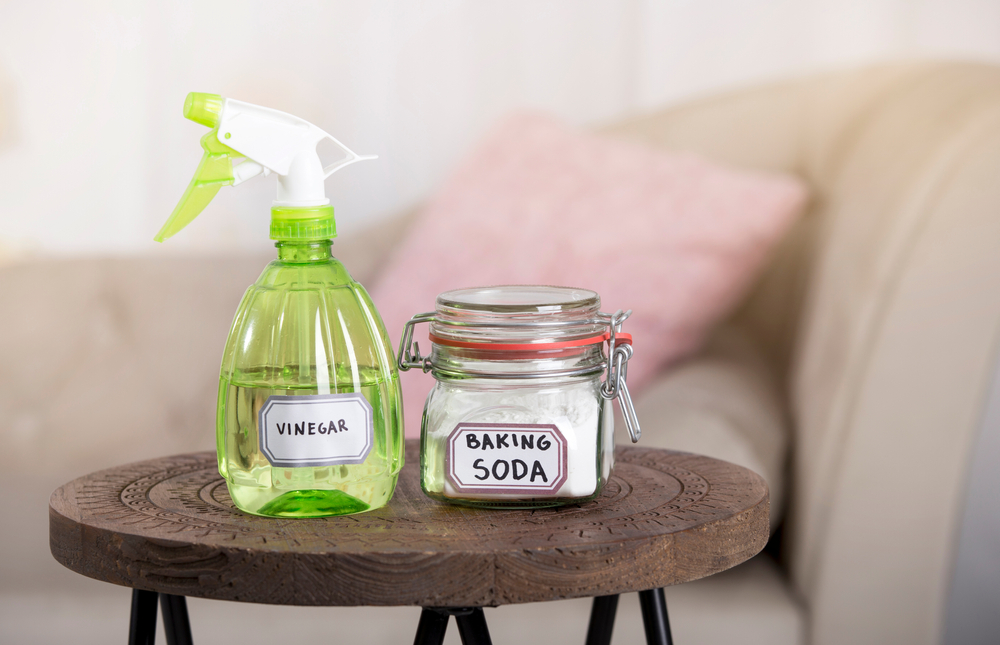Vinegar is an excellent cleaning agent, but it has an incredibly strong smell. For this reason, it’s best to avoid using vinegar on soft fabrics, as it can be difficult to get rid of the smell. But, it can be used in very small amounts, or mixed in with water.
To use vinegar on a sofa, pour one part white vinegar and two parts water into a spray bottle and spritz the dirty area. If you are trying to get rid of a smell, then it should dissipate relatively quickly. You can even add in some essential oils if you want to give the sofa an even nicer smell.
If you are cleaning a leather sofa, then you need to be a little more careful as it can dry out the leather. To remove a stain on a leather sofa, simply dilute the vinegar a little more.

Does vinegar ruin upholstery?
This depends on the type of vinegar. To clean a sofa, it’s best to use straight white vinegar, and not white wine vinegar. Also avoid any dark vinegar, including red wine vinegar and apple cider vinegar.
Apple cider vinegar can be a good cleaning agent, but it has an incredibly strong smell and a relatively dark color. So it’s best to stick to straight white vinegar.
Do you have to rinse after cleaning with vinegar?
This depends on the fabric you’re cleaning. Something which has a deep thread will be fine as it will absorb the vinegar. This is actually a good thing as it will clean deeper down, which is preferable if you’re trying to get rid of a smell.
If you’re working on a smooth surface, such as a leather sofa, then it might be a good idea to work the vinegar into the area.
Or you can leave it on for a few minutes to work and then wipe it off. This will reduce the risk of the vinegar drying out the leather sofa and potentially causing a stain.
What is the difference between white vinegar and distilled vinegar?
The main difference between white vinegar and distilled vinegar is the amount of acetic acid. White vinegar has a higher level of acetic vinegar.
White vinegar, also known as spirit vinegar due to its ethanol content, can have between 5% and 20% acetic acid. Whereas distilled vinegar usually has around 8% acetic acid.
Both white vinegar and distilled vinegar can be used for cleaning. Distilled vinegar usually doesn’t have a coloring agent, but white vinegar sometimes does. So it’s worth looking into the production process and ingredients list to make sure it won’t damage your furniture.
Will vinegar ruin my couch?
Not if you use it properly and don’t use it too often. Regularly using vinegar, or any kind of liquid, on soft furnishings can cause them to become damp and develop mold. Vinegar is also a good cleaner for mold, but this doesn’t mean that it can stop mold from growing entirely.
So, vinegar should only be used for tough stains and bad smells. Otherwise, vacuuming and general cleaning is enough for a sofa. Regularly using vinegar on upholstery is not a good idea, as even when diluted it can be corrosive.
Can baking soda damage a sofa?
Baking soda is regularly used alongside vinegar as a cleaning agent. They work incredibly well together, especially for removing stains. But this is best avoided for a sofa, especially one which is made from a soft, deep fabric.
The grains of baking soda, even when mixed in with the vinegar, will become stuck within the material. For a leather sofa, there is also a risk that the baking soda can scratch the fabric.
Baking soda can be used as a deodorizer when dry, but it will need to be vacuumed up afterward. And there is a risk that, as the grains are so small, a lot of vacuums won’t be able to remove all of them.
So, while baking soda is a good cleaning agent, it’s best to stick with diluted vinegar when it comes to cleaning a sofa.
How do I get baking soda residue off my sofa?
If you did choose to use baking soda, it can be difficult to remove. If you used it when dry, then try to vacuum it up. If this doesn’t quite work, take a handheld brush and try to brush it onto the floor.
Brush the cushions in the same direction, toward the front of the sofa. Don’t rub the baking soda into the fabric and avoid using circular motions.
If the baking soda has left a stain, you can actually use vinegar to remove this. In a bowl, mix three parts warm water to one part white vinegar. Soak a sponge into this mixture and then dab at the stain on the sofa.
Once the area is wet, lay a dry towel or cloth over it and press down. This should absorb both the diluted vinegar and the baking soda residue. Repeat for at least three times. Leave to dry and then come back. If the residue is still there, then repeat.
Will vacuuming up baking soda ruin my vacuum?
This depends on the filters in your vacuum cleaner. The grains of baking soda are incredibly small and if there is even a small amount of liquid in your vacuum cleaner, there is a chance that it will clump up.
So, it’s best to change the bag or empty the collection bin after vacuuming up baking soda. It’s also a good idea to try to clean out your vacuum cleaner, including the tubes and pieces you used to vacuum up the baking soda. Especially if you used a piece with brush bristles attached.
If you have used water and vinegar as well, then there’s a much bigger risk of your vacuum cleaner being damaged. Vacuum cleaners should never go over liquid. When added to a liquid, baking soda doesn’t dissolve but instead clumps up.
